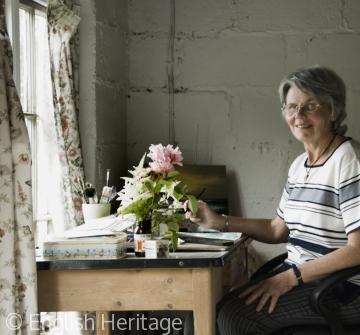Scholars and Artists
 Artist Maureen Semmens at Orchard Cottage and Studios in Newlyn, Cornwall.
Artist Maureen Semmens at Orchard Cottage and Studios in Newlyn, Cornwall.Early scholars were usually monks like Roger Bacon from Ilchester, Somerset and Bede of Jarrow, author of The Ecclesiastical History of the English People. After the founding of Cambridge and Oxford Universities, scholarship was widely disseminated among clergy, gentry and lawyers. Men like political philosopher Thomas Hobbes (d. 1679) were able to earn a living as tutors and secretaries in aristocratic households. Some of the books Hobbes collected are still in the library at Chatsworth. William Scawen, 17th-century scholar and judge from St Germains, Cornwall was a passionate advocate for the Cornish language. Sir Frank Crisp builder of the extraordinary Friar Park at Henley, Oxfordshire was not only a successful company lawyer but also studied horticulture, landscape gardening, natural history, and microscopy, becoming a leading member of both the Royal Microscopical Society and the Linnaean Society.
Writers and poets have often risen from modest beginnings to national fame like John Masefield of Ledbury, Herefordshire or Alfred Edward Housman from Fockbury, Worcestershire but they still sought inspiration from the area where they grew up.
Musicians and composers have also taken inspiration from their local landscape like Edward Elgar with his affinity to the Malvern Hills. Others like Thomas Lynley of Bath are now little known although he played with Mozart as a fellow child prodigy.
Artists were often influenced by their early life and surroundings but some found their ideal workplace later in life. Many are strongly associated with particular places like Constable with Essex, Lowry with Salford or Barbara Hepworth with St Ives. Other artists were visitors like the Flemish landscape painter Jan Siberechts who in the 1690s produced several views of Henley, Oxfordshire and the River Thames. Artists like Thomas Lawrence of Bristol. came to Bath in the 18th century to paint its wealthy visitors.
Some areas are noted for schools of painting especially Norwich and Newlyn. Areas like Exmoor and Cumbria have attracted artists for centuries. Painters like Ann le Bas of Winsford continue the tradition. In the 18th and 19th century there was a great demand for topographical drawings such as those produced by the Bucklers or small watercolours as a souvenir of a tour of Britain.
There must be many other talented people who for various reasons never achieved national fame but whose work rewards the diligent researcher in local archives.










